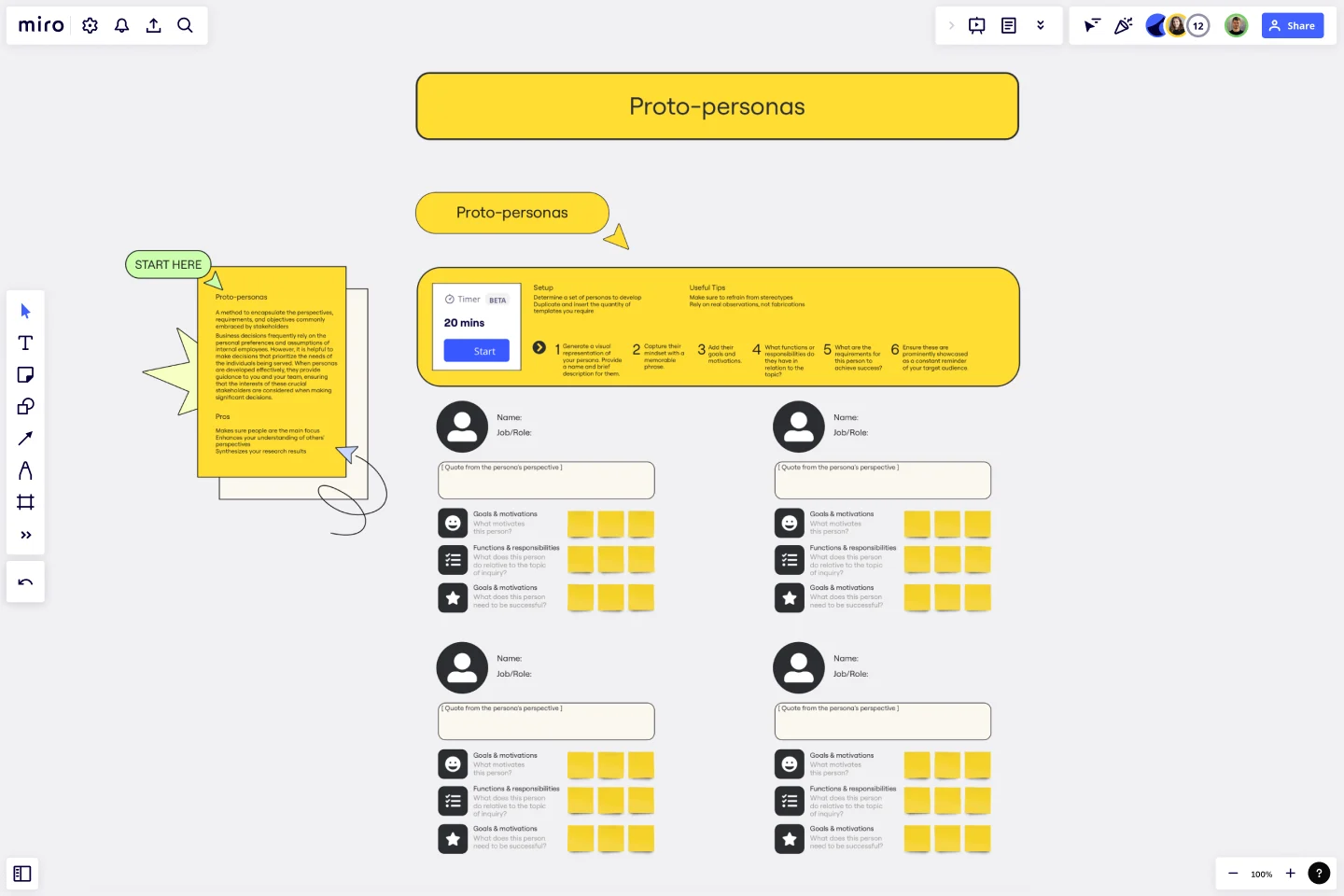Proto Persona Template
Identify and understand the perspectives, requirements, and objectives that are commonly embraced by stakeholders with the Proto Persona Template.
About the Proto Persona Template
Business decisions often rely on the personal preferences and assumptions of internal employees. However, it is essential to prioritize the needs of the people served when making decisions.
The Proto Persona Template can help you identify and understand the perspectives, requirements, and objectives commonly embraced by stakeholders. When personas are developed effectively, they guide you and your team, ensuring that the interests of these crucial stakeholders are considered when making significant decisions.
Benefits of using the template
Make sure people are the main focus.
Enhance your understanding of others' perspectives.
Synthesize your research results.
How to use the template
Generate a visual representation of your persona. Provide a name and brief description for them.
Capture their mindset with a memorable phrase.
Add their goals and motivations.
What functions or responsibilities do they have in relation to the topic?
What are the requirements for this person to achieve success?
Ensure these are prominently showcased as a constant reminder of your target audience.
Setup
Determine a set of personas to develop.
Duplicate and insert the quantity of templates you require.
Useful tips
Make sure to refrain from stereotypes.
Rely on real observations, not fabrications.
Get started with this template right now.
2x2 Prio Matrix Template
Works best for:
Design
Understanding the balance between importance and difficulty is crucial for effective decision-making and progress. To aid in prioritization, a simple 2x2 matrix can map these factors on the x-axis and y-axis, respectively. This framework allows you to assess the trade-offs and tensions involved. The lower left quadrant represents quick wins, while the upper left quadrant consists of luxury items that may be costly with limited returns. The upper right quadrant contains strategic items that require significant investments for substantial results. Finally, the lower right quadrant houses the most valuable items, offering high impact at a lower cost.
Experience Mapping Template
Works best for:
Desk Research, Mapping
Plan your product according to your customer’s needs and desires with the Experience Map Template. Bring a customer-centric approach to product development and branding.
Empathy Map by Back of the Napkin Consulting
Works best for:
Research & Design, Market Research
The Empathy Map template is designed to help you understand your users deeply. It captures user behaviors, thoughts, and feelings, allowing you to design products that truly resonate with their needs. Use this template to enhance your UX research and create user-centered designs.
Product Development Roadmap Template
Works best for:
Product Management, Software Development
Product development roadmaps cover everything your team needs to achieve when delivering a product from concept to market launch. Your product development roadmap is also a team alignment tool that offers guidance and leadership to help your team focus on balancing product innovation and meeting your customer’s needs. Investing time in creating a roadmap focused on your product development phases helps your team communicate a vision to business leaders, designers, developers, project managers, marketers, and anyone else who influences meeting team goals.
Empathy Map Canvas by Sampriti Jain
Works best for:
Market Research, Strategy & Planning
The Empathy Map Canvas template allows you to explore user behaviors and emotions comprehensively. It’s designed to help you visualize user experiences and create solutions that truly meet their needs. Perfect for UX teams and product developers.
Pass the Paper
Collaborative brainstorming is an excellent method to facilitate a group of individuals in generating a diverse range of innovative concepts related to a specific problem. By encouraging participants to build upon each other's ideas, the process allows for rapid evolution and unexpected transformations. This collaborative approach, known as Round Robin, emphasizes collective authorship, with each person contributing their unique perspective. The ultimate outcome is a collection of ideas that surpasses the imagination of any individual.
